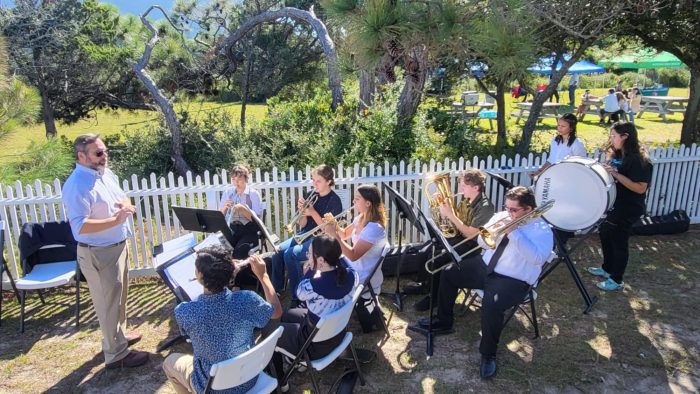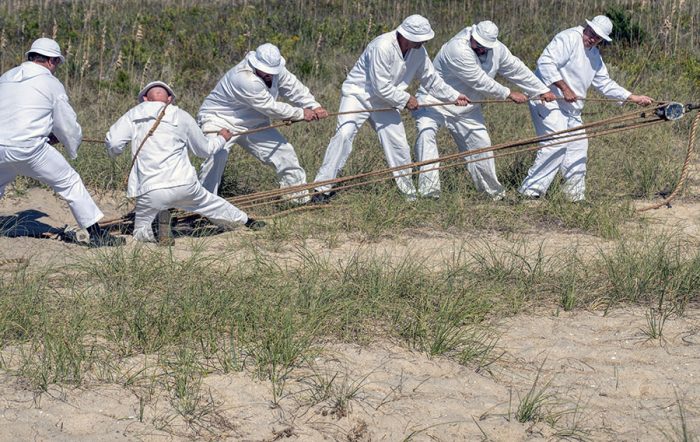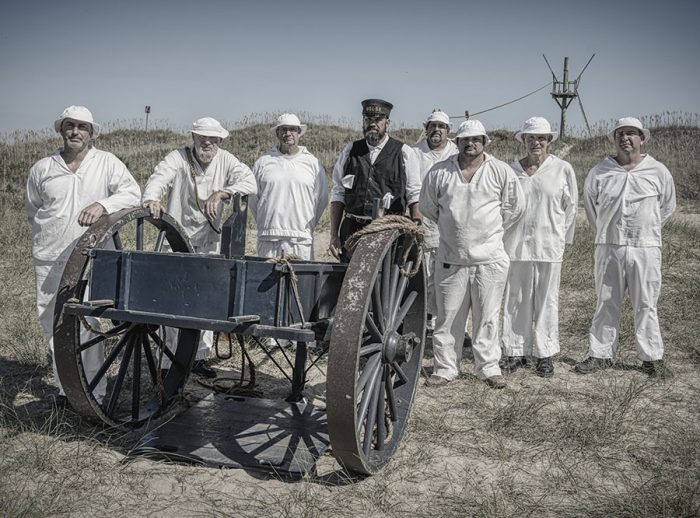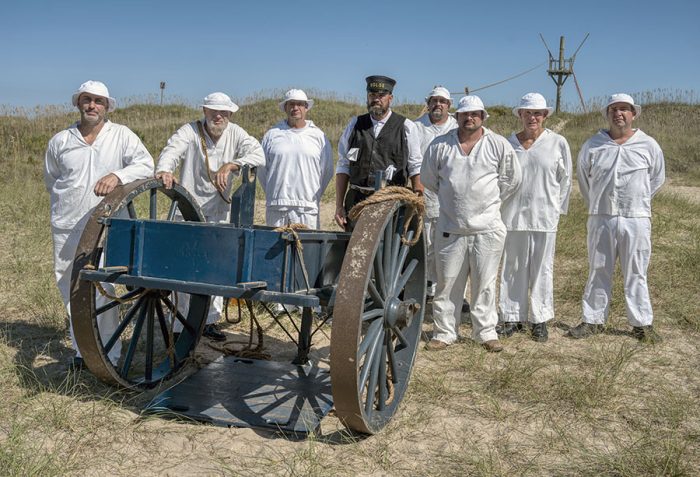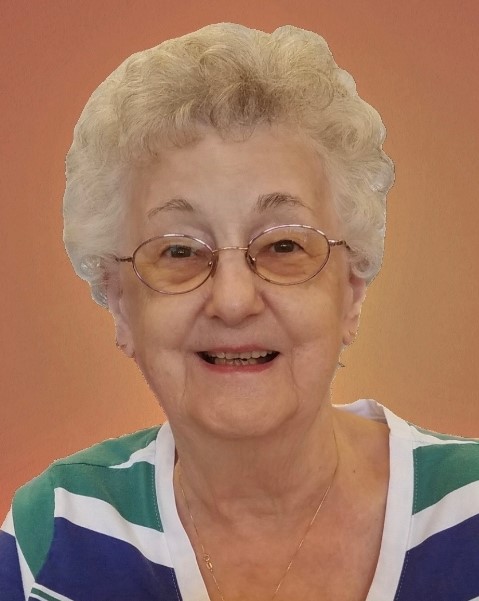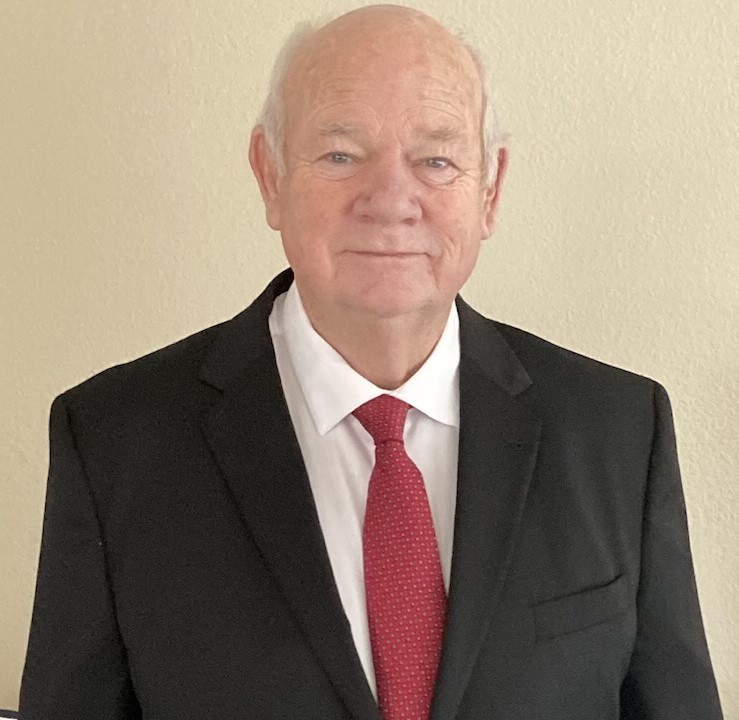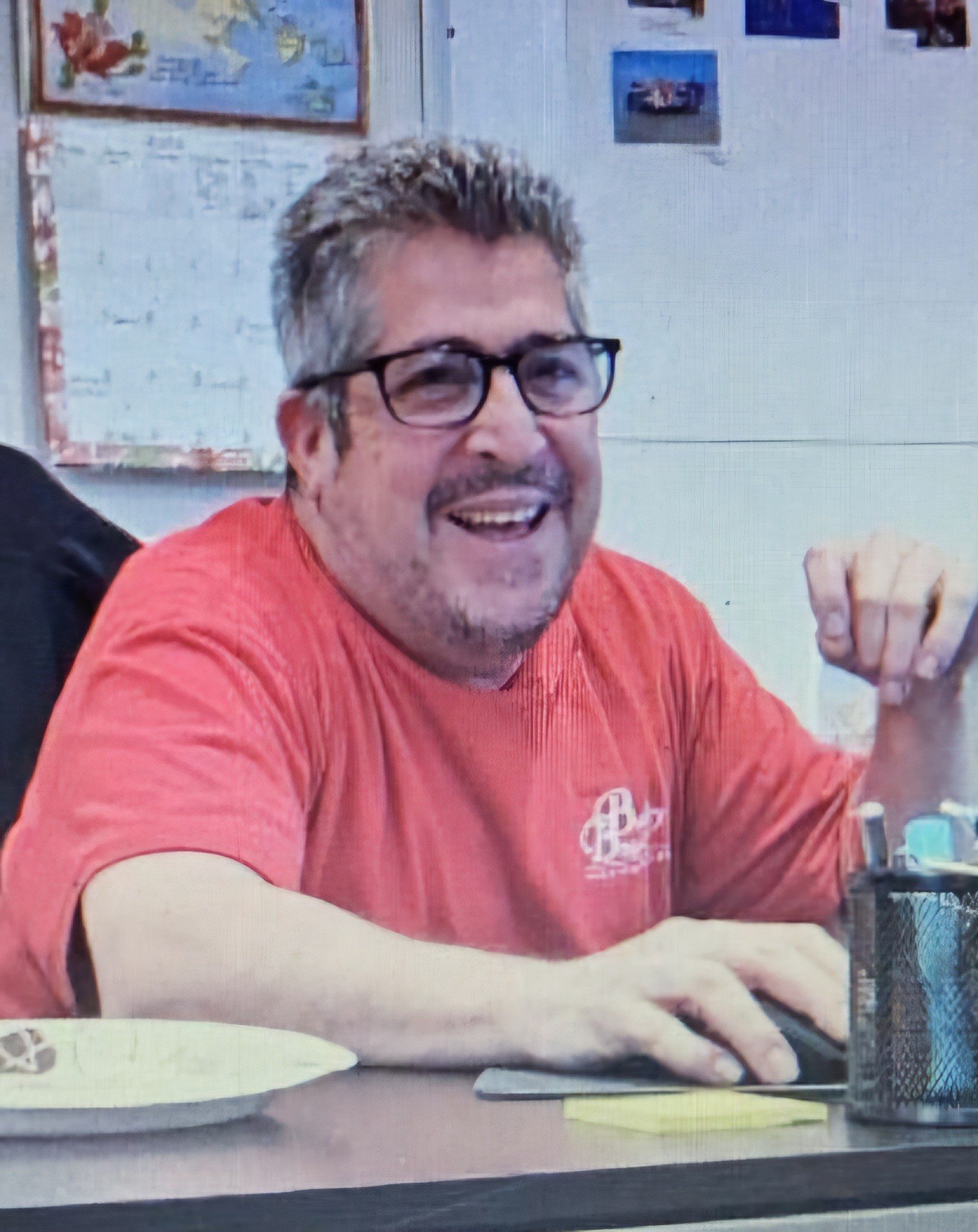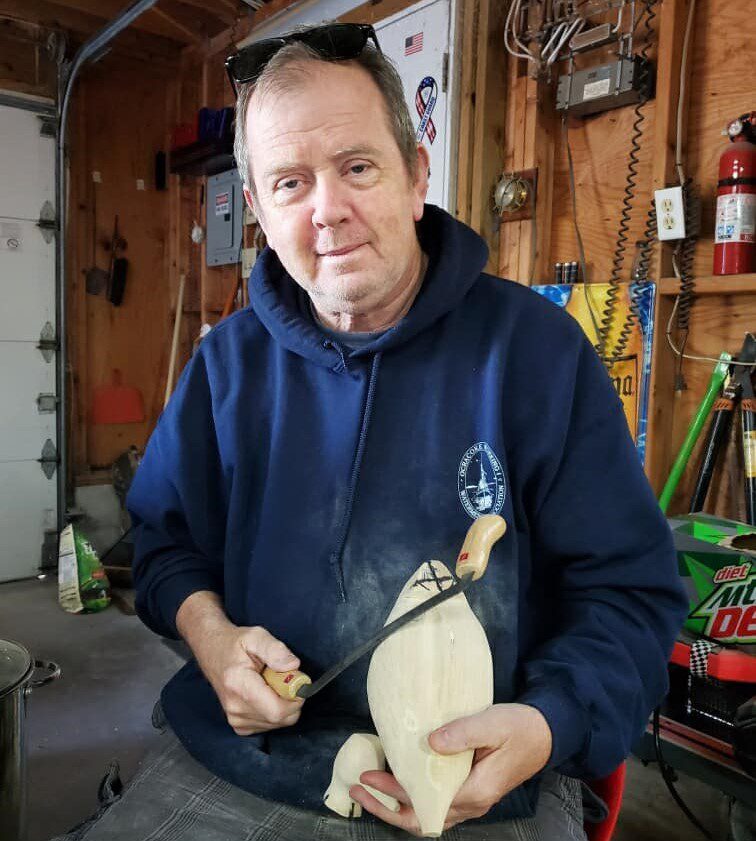Past and present converge at 150th anniversary celebration of North Carolina’s Life-Saving Service
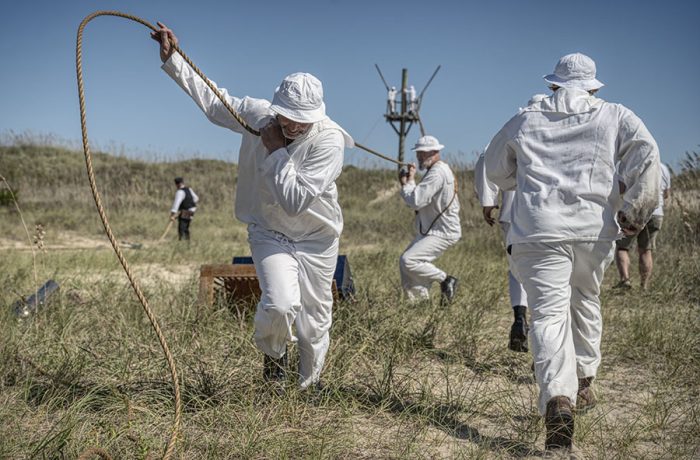
The 1874 establishment of seven U.S. Life-Saving Service Stations in North Carolina had reverberations that are still very much noticeable today. The seven stations – all located within the Outer Banks – created new communities and generations of locals that still call the Outer Banks home. In 1915, the Life-Saving Service became the newly-created United States Coast Guard, and throughout the past 150 years, thousands of lives have been saved off local shores because of these two successive agencies.
This deep history and interwoven connections were highlighted at a two-day 150th Anniversary event on Oct. 12-13 at the Chicamacomico Life-Saving Station in Rodanthe, where the past, present, and future of dedicated, on-the-water heroes was honored.
Because 150 years of stories had to be condensed in a two-day timeframe, the 150th Anniversary Celebration was divided up into two themes – Saturday’s events focused on the way things were done “back then,” when the U.S. Life-Saving Service was in its late-1800s/early-1900s heyday, while Sunday focused on how life-saving operations are conducted now.
With the newly-restored 1874 Chicamacomico Station on full display, and tours occurring on both days at historic Life-Saving Stations throughout the Outer Banks, the significance of these original seven Life-Saving Stations was constantly in the backdrop of the multiple programs and activities throughout the weekend.

“Before 1874, if you were a shipwrecked mariner, you were at the mercy of whoever happened to be walking down the beach at the time,” said author and historian Kevin Duffus. “And really, it was the result of two significant shipwrecks – the USS Huron, a Navy warship that wrecked in Nags Head, and then a couple months later, the Metropolis… Both of those resulted in hundreds of deaths, and there were no Life-Saving Stations at the time.
“So, with the establishment of the 1874 stations – which included Chicamacomico – for the first time, mariners could feel like there was someone on shore who was looking out for them. It was really a great turning point in maritime history.”
The dedication of the U.S. Life-Saving Service was on full display throughout the weekend, and particularly during Saturday afternoon’s Beach Apparatus Drill reenactment.
For years, a team of local volunteers have conducted these weekly reenactments which demonstrate a routine drill that all Outer Banks station crews had to repeat to ensure that the steps required to perform a rescue in ocean waters was second nature.
Chicamacomico Life-Saving Station is the only site of its kind to perform this reenactment, and the team has even been asked to take their show on the road, such as at the annual U.S. Life-Saving Service Heritage Association (USLSSHA) Conference in Maine in 2023.
During the roughly 10-minute demonstration, each member of an eight-man team has a specific role to successfully launch a breeches buoy out into the ocean in order to pull ashore stranded victims. (A breeches buoy is a rescue apparatus that looks like a life preserver, but with built-in shorts.)
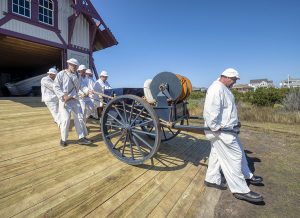
Decked out in canvas “summer uniforms,” the volunteer team pulls a half-ton wagon to the edge of the ocean. From here, a Lyle Gun is fired to set the pulley system that will eventually haul the people in peril to shore, while other members of the team set up the crotch poles and heavy rope lines that will keep the pulley system stable and operational.
It’s a flurry of movement, with ropes flying in every direction, surfmen climbing to the top of a wreck pole, and loud gunfire that startles onlookers.
The reenactment ends with one of the recused shipwreck victims, (usually a young volunteer from the audience), being placed in the breeches buoy before they are launched from the 17-foot-tall wreck pole platform to the ground.
On Saturday’s demonstration, drill team member and active U.S. Coast Guard member Ryan Gentry’s son, 10-year-old Mason, bravely volunteered to be propelled through the air as the final stage of the drill.
“This is the third time he has [volunteered], so he definitely has some experience now,” said Gentry.
Larry Grubbs, President of the Chicamacomico Board of Directors and longtime drill team leader, said Saturday’s demonstration attracted the largest number of spectators all season, and that the evet was especially unique because of the crowd of Coast Guard personnel, Life-Saving Station descendants, historians, and other folks with ties to Chicamacomico and the Life-Saving Service.
“It’s always fun for us when we are engaging with a crowd that has a lot more knowledge about [the Life-Saving Service],” said Grubbs. “It makes us have to bring our A game.”
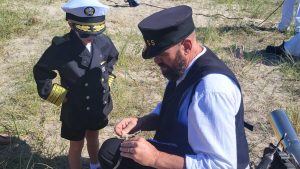
After the afternoon demonstration, the significance of the event and he 150th anniversary was further celebrated via a series of speakers who were connected to the Life-Saving Service in some notable way.
This included local surfmen descendent Jackie Wenberg, NC Department of Natural and Cultural Resources Education Curator Ben Wunderly, Cape Hatteras National Seashore’s Chief of Interpretation and Visitor Services Scott Babinowich, Master Chief and USCG Ancient Keeper Christopher Hinote, and keynote speaker USCG District 5 Commander Rear Admiral (RADM) John “Jay” Vann.
After patriotic music provided by members of the CHSSCS band, a presentation of Colors by Camden High School’s USCG Jr. ROTC, and an invocation by Reverend Pam Stoffel, the speakers detailed how the template set by North Carolina’s Life-Saving Service continued to be honored and followed today.
During his keynote address, Vann touched on this correlation between past and present, and noted that the 150-year tradition of risking lives to save lives would continue well into the future.
“While we all value a look back into history, I think the future is bright,” said Vann. “The young members of our U.S. Coast Guard that [we] meet have incredible promise. They are smart, innovative and respectful.
“I think that despite the divisiveness we increasingly observe, and the doubts some of us have in younger generations, you will find that the young American service members in our Coast Guard respect our heritage, and those who came before us… these Coast Guard servicemen and women who are part of this community are heroes, and they are committed to protecting you.”
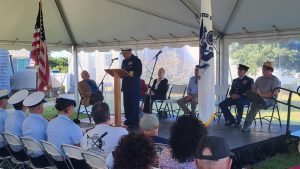
From the modern USCG surfboat and helicopter that was showcased at the historic Rodanthe site on Sunday, to the tours of Little Kinnakeet Life-Saving Station and other historic sites that lingered into Monday, 150 years of maritime history were effectively condensed into a sprawling celebration.
Though it took more than a year to plan, which included weekly historical articles by Jen Carlson, enlisting speakers and presenters, and the ongoing restoration of the 1874 Chicamacomico Station, organizers and participants state effort was well worth the results.
“I think this came together really well, and I’m glad we have so many U.S. Coast Guard personnel here with us attending this weekend,” said John Griffin, Chicamacomico Life-Saving Station Executive Director.
“I so appreciate the folks and various associations and organizations that put the effort into recognizing this history, because it’s definitely something that is worth keeping,” said Vann.
“We appreciate it, because we’re the continuing history,” he added. “We’re happy to carry on the history, and we really appreciate the local people keeping the history alive.”
